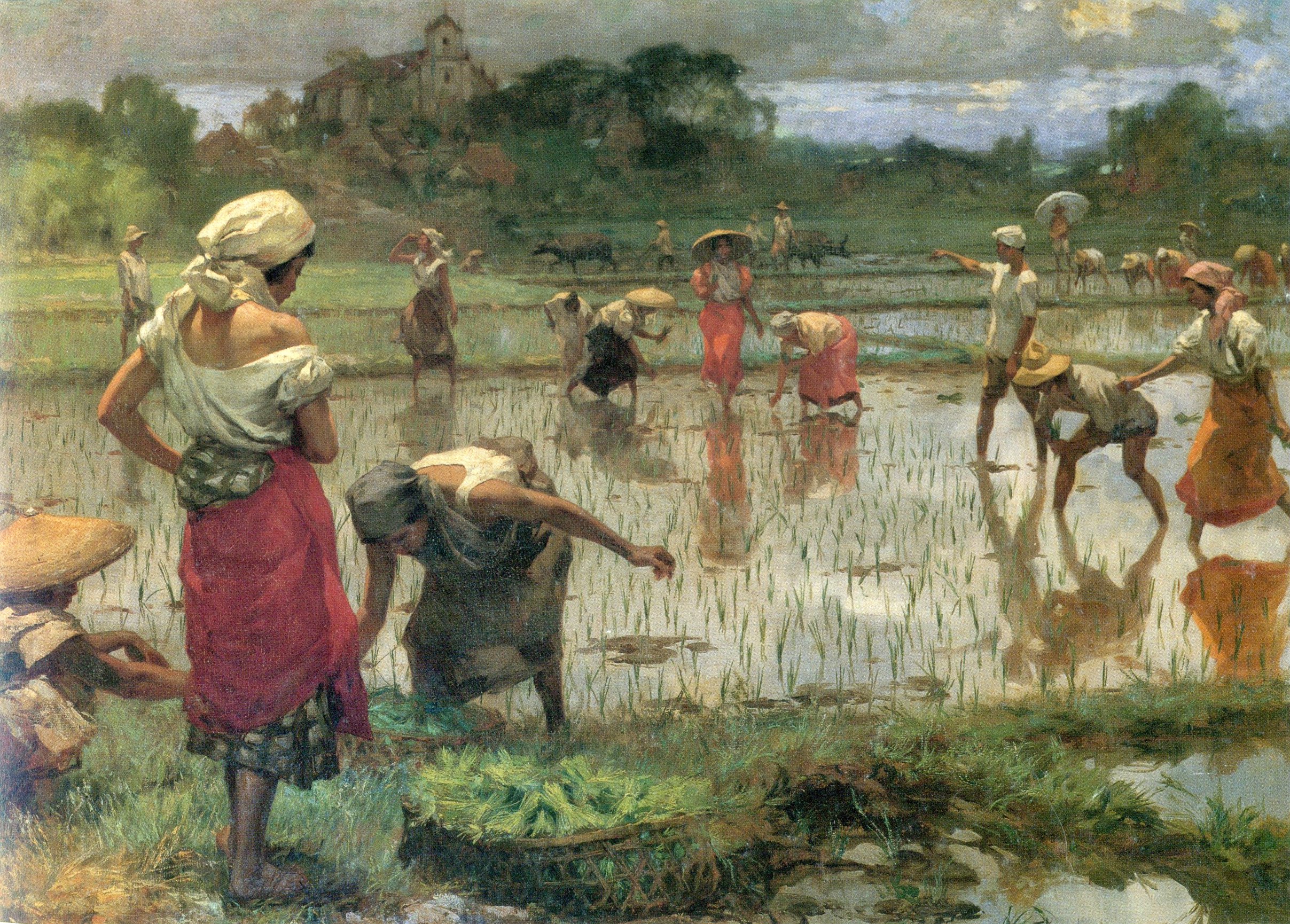Cultural Center of the Philippines
ENCYCLOPEDIA OF
PHILIPPINE ART
Planting Rice [Fernando Amorsolo]
1921 / Oil on canvas / 95.5 x 131 cm / Artist: Fernando Amorsolo / Felisa Valenzuela Hocson collection
This 1921 oil painting by Fernando Amorsolo (Roa 1992, 97) is the earliest known version of a series of works, also titled Planting Rice, done by Amorsolo from 1921 to 1944. Another larger version, also titled Planting Rice and dated 1924, is in the Paulino and Hetty Que collection (Cruz 2008, 96-7). Both paintings share almost the same composition. The scene is set in a wet rice field with shallow pilapil (rice paddy) hedges forming orthogonal patterns rising toward the left horizon line. The field is populated by three groups of farmers. Three women in the left foreground are centered around a woman standing with her back to the viewer, a red tapis (outer skirt layer) covering her checkered saya (dress), and her right sleeve undone to show her bare shoulder. A second group is in the middle ground composed of nine figures positioned around another woman wearing a flaming orange saya and conical hat. A third group is in the right background, broken into a left grouping of two farmers with carabaos, and another seven farmers planting rice on the right. The horizon is dominated by a slight rise at upper-middle left, surmounted by a church with a single bell tower at its center pediment surrounded by trees. The sky is heavy with gray rain clouds, indicating that this is monsoon planting season, and casts a slight overcast light over the scene. An openwork basket filled with rice shoots ready for planting is at the center foreground, counterbalancing both the church at the upper-left background and the figures distributed from left foreground to right background. The 1924 version varies via the use of a slightly more intense sunlight, throwing most of the human figures under stronger shadows, and lighting up the rice shoots in the foreground, as well as the planted rice field in the left background.
Amorsolo’s Planting Rice is a recapitulation of Fabian de la Rosa’s 1904 prizewinning entry at the Saint Louis World’s Exposition, but situates it in a more suburban milieu. The highly sensualized depictions of women farmers (Roa 1992, 96-97) also change Amorsolo’s narration of the rice planting scene from a depiction of agrarian economic production to a more nuanced association of agriculture with female fertility and reproductive sexuality. The use of more vigorous brushwork, particularly on the clothing and bare shoulder of the woman at left foreground, also indicates Amorsolo’s adaptation of Spanish Impressionist models like that of Joaquin Sorolla, albeit still modulated with a leaden gray lighting in tune with the academic classicism of Fabian de la Rosa. The various versions of Planting Rice also confirm Amorsolo’s habit of making multiples of the same title with slight variations, a trait also taken from de la Rosa. In no small part due to Amorsolo, the subsequent patronage from art collectors, and repeated appearances in educational publications, “planting rice” as a subject matter in painting became an iconic image in Philippine art history.
Written by Reuben R. Cañete
Sources
Castañeda, Dominador. 1964. Art in the Philippines. Quezon City: Office of Research Coordination, University of the Philippines.
Cruz, May Lyn. 2008. “Philippine Staple: The Land, The Harvest, and the Maestro.” In Fernando Amorsolo: Seven-Museum Exhibition, 89-113. Manila: ArtPostAsia.
Roa, Lourdes R. 1992. “The Leap to Modernism.” In Art Philippines, A History: 1521-Present, edited by Juan T. Gatbonton, 65-115.
Mandaluyong City: The Crucible Workshop.
Roces, Alfredo R. 1975. Amorsolo (1892-1972). Makati: Filipinas Foundation.
